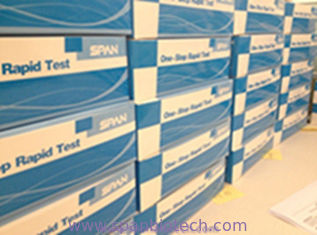|
|
PPRV Ab - Porcine Pseudorabies Ab Test
|
Product Details:
Payment & Shipping Terms:
|
| Specificity: | 100% |
|---|
For samples : serum, plasma, culture media or any biological fluid.
FOR RESEARCH USE ONLY !
PPRV Ab - Porcine Pseudorabies Ab Test
NOT FOR THERAPEUTIC OR DIAGNOSTIC APPLICATIONS !
PLEASE READTHROUGH ENTIRE PROCEDURE BEFORE BEGINNING !
Purpose
Our sheep Peste des petits ruminants antibody(PPR-Ab) ELISA kit is to assay PPR-Ab levels in Sheep serum, plasma, culture media or any biological fluid.
This ELISA kit uses Sandwich-ELISA as the method. The Microelisa stripplate provided in this kit has been pre-coated with an antigen specific to PPR-Ab. Standards or samples are added to the appropriate Microelisa stripplate wells and combined to the specific antigen. Then a Horseradish Peroxidase (HRP)-conjugated antigen specific for PPR is added to each Microelisa stripplate well and incubated. Free components are washed away. The TMB substrate solution is added to each well. Only those wells that contain PPR-Ab and HRP conjugated PPR antigen will appear blue in color and then turn yellow after the addition of the stop solution. The optical density (OD) is measured spectrophotometrically at a wavelength of 450 nm. The presence of PPR-Ab is determined by comparing with the CUTOFF value.
Materials provided with the kit
|
|
Materials provided with the kit |
96 determinations |
Storage |
|
1 |
User manual |
1 |
R.T. |
|
2 |
Closure plate membrane |
2 |
R.T. |
|
3 |
Sealed bags |
1 |
R.T. |
|
4 |
Microelisa stripplate |
1 |
2-8℃ |
|
5 |
Negative control |
0.5ml×1 bottle |
2-8℃ |
|
6 |
Positive control |
0.5ml×1 bottle |
2-8℃ |
|
7 |
HRP-Conjugate reagent |
6ml×1 bottle |
2-8℃ |
|
8 |
Sample diluent |
6ml×1 bottle |
2-8℃ |
|
9 |
Chromogen Solution A |
6ml×1 bottle |
2-8℃ |
|
10 |
Chromogen Solution B |
6ml×1 bottle |
2-8℃ |
|
11 |
Stop Solution |
6ml×1 bottle |
2-8℃ |
|
12 |
wash solution |
20ml (30X)×1bottle |
2-8℃ |
Sample preparation
1. Serum preparation
After collection of the whole blood, allow the blood to clot by leaving it undisturbed at room temperature. This usually takes 10-20 minutes. Remove the clot by centrifuging at 2,000-3,000 rpm for 20 minutes. If precipitates appear during reservation, the sample should be centrifugated again.
2. Plasma preparation
Collect the whole blood into tubes with anticoagulant (EDTA or citrate). After incubated at room temperature for 10-20 minutes, tubes are centrifugated for 20 min at 2,000-3,000 rpm. Collect the supernatant carefully as plasma samples. If precipitates appear during reservation, the sample should be centrifugated again.
3. Urine samples
Collect urine into aseptic tubes. Collect the supernatant carefully after centrifuging for 20 min at 2,000-3,000 rpm. If precipitates appear during reservation, the sample should be centrifugated again. The preparation procedure of cerebrospinal fluid and pleuroperitoneal fluid is the same as that of urine sample.
4. Cell samples
If you want to detect the secretions of cells, collect culture supernatant into aseptic tubes. Collect the supernatant carefully after centrifuging for 20 min at 2,000-3,000 rpm. If you want to detect intracellular components, dilute the cells to 1X106/ml with PBS (pH 7.2-7.4). The cells were destroyed to release intracellular components by repeated freezing and thawing. Collect the supernatant carefully after centrifuging for 20 min at 2,000-3,000 rpm. If precipitates appear during reservation, the sample should be centrifugated again.
5. Tissue samples
Tissue samples are cut, weighed, frozen in liquid nitrogen and stored at -80℃ for future use. The tissue samples were homogenized after adding PBS (pH 7.4). Samples should be operated at 4℃. Collect the supernatant carefully after centrifuging for 20 min at 2,000-3,000 rpm. Aliquot the supernatant for ELISA assay and future use.
Notes:
1.Sample extraction and ELISA assay should be performed as soon as possible after sample collection. The samples should be extracted according to the relevant literature. If ELISA assay can not be performed immediately, samples can be stored at -20℃.Repeated freeze-thaw cycles should be avoided.
2. Our kits can not be used for samples with NaN3 which can inhibit the activity of HRP.
Span Biotech Ltd.
Tel: +86(755)89589611
WhatsAPP:+8618823462100 (Wechat)
Web:www.spanbio.com
Contact Person: Ms. Anna Lee
Tel: +86-755-89589611
Fax: 86-755-89580096




